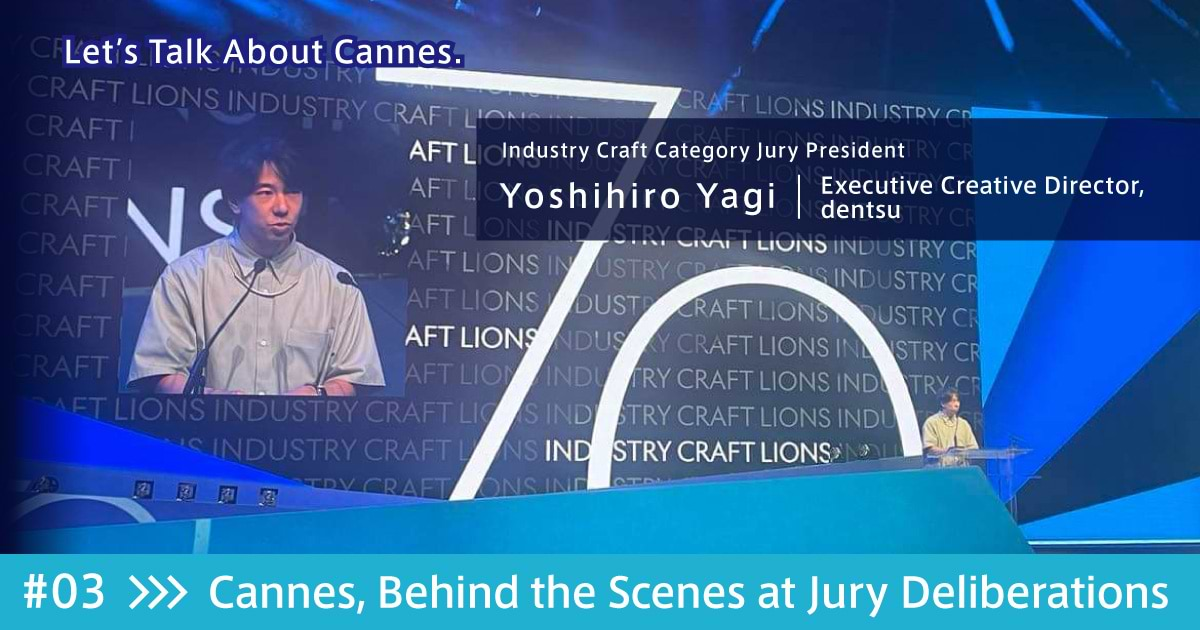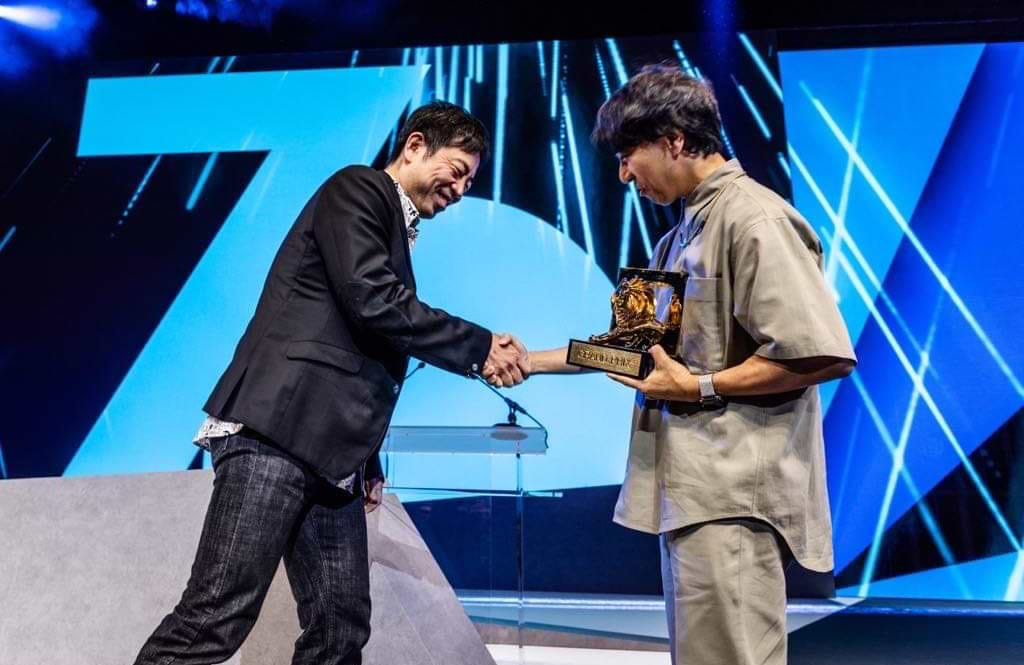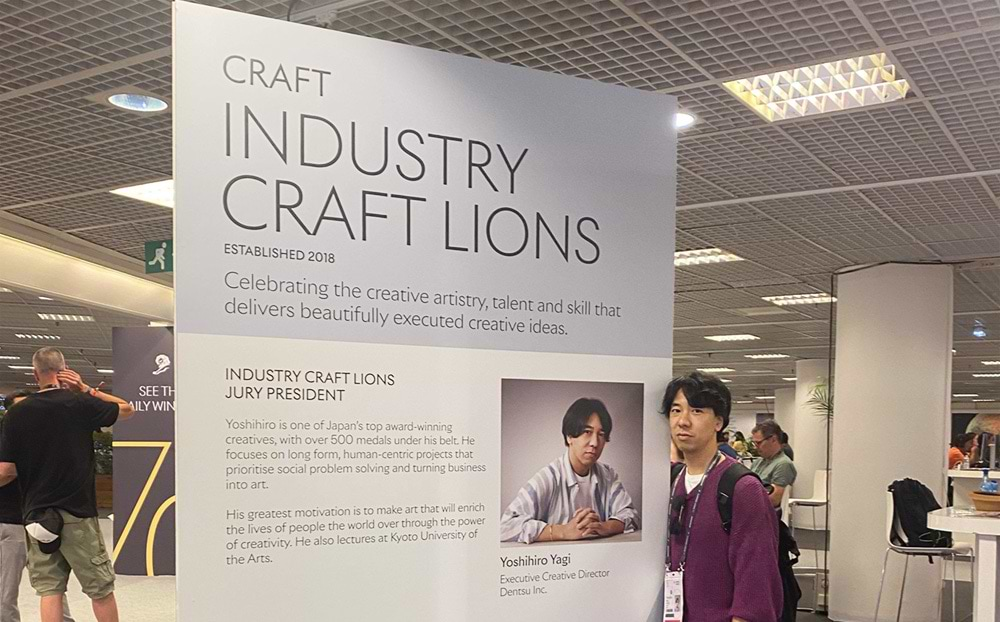(This article is reprinted from Web Dentsu-ho article published in December 2023.)
The Cannes Lion International Creativity Festival 2023 was held from June 19 to 23, 2023. How did creators view this year’s edition of the world’s largest annual creativity festival held in France? Prize winners, jury members, presenters, and other creators involved with the occasion in various capacities reveal their perspectives on the event.

In this third installment, we interview dentsu zero Executive Creative Director Yoshihiro Yagi, who served as the Industry Craft category jury president. What was Cannes like from the perspective of the jury? And behind the scenes during the actual judging?
We asked about the role of the jury president, the judging process, and the differences between the creativity of Japanese and overseas entrants.

Jury Decisions: a Message to the World
—What was it like at Cannes Lion this year?
Yagi: In 2023, there was great joy because the jurors were able to attend in person again after the COVID-19 pandemic. This year, the festival seemed to be back to normal, with everyone having a good time, starting when they were reunited with fellow jury presidents from around the world.
Looking at the award-winning works as a whole, most seemed somewhat relaxed and carefree, basic and straightforward in their approach to brands. Over the past three years, we have seen how stories from faraway countries can have a major impact on us, and as these stories have come to be shared, my sense is that feelings of connection and altruism are becoming the norm.
—As jury president, how would you describe the Industry Craft category?
Yagi: The Industry Craft Lions celebrates the creative artistry, talent, and skill required to deliver a beautifully executed solution that brings a creative idea to life. I have been a member of the Design category jury twice so far, and each time during the deliberation process, I have felt that the meaning of craft—as commonly understood in Japan—is narrower than the meaning conveyed in jury room conversations.
Rather than craft as a skill—which is how it is defined in the communication industry—industry craft is seen as seeking to move people’s hearts. It has a major impact on perception, what we can call the final texture, at the intersection of brands and consumers. I see Industry Craft as being a category that evaluates the way in which a brand’s vision is expressed.
—What was your role as a Cannes Lion jury president?
Yagi: First, as jury president I had to announce the judging criteria online ahead of the preliminary deliberations. I proposed that we look for emotional connections between brands and users, since we wanted to redefine craft in this increasingly AI-driven age.
In addition to the technical qualities of craft, I had the judges take into consideration whether the brand was committed to its stated ethics, and was engaged in something it truly wanted to do for the world. In short, do people choose it as a brand they want to support and empathize with, and are they willing to pay a certain price for it?
Further, keywords were provided to assist the jury in developing an intuitive perspective when deliberating. In the jury room, three criteria were displayed: enrichment > convenience, emotion > function, and dreams > efficiency.
Our evaluation criteria were based on the idea that human factors, such as enrichment and abundance, are more important than convenience; emotions and feelings are more important than function; and the future and dreams are more important than efficiency.
I felt that I also wanted to see an AI process that could meet these criteria. That said, I felt a bit embarrassed when I explained my idea to the jury, wondering whether I might have sounded somewhat naive. I was relieved when everyone agreed with me, however, since I believe we live in an age in which such openness is necessary.
The jury members were all involved in craft-related evaluation, and I think there was a good balance of people from different backgrounds, including designers in the field of architecture, creative directors who were originally copywriters, and chief creative officers (CCOs) from advertising agencies, hailing from Asian nations, the United States, and European countries, one member being from Ukraine. Everyone was a good listener and very kind.
The jury president does not vote in the final decision. The jury president’s job is to facilitate discussions leading up to the vote, and to ensure an adequate supply of high-quality materials to assist with decision-making. Wishing to motivate the jury to ensure discussions were thoughtful, I carefully managed the allotted time and kept the proceedings lively.
My biggest task as jury president was to work with jury members from a variety of backgrounds and to create a message to the world through this year’s winning works. At the awards ceremony I presented the prizes and, as jury president, I was able to meet the winners in person. When I went up on stage, my heart full of congratulations, I was very nervous.
—This year, in a dramatic finale, the JR Group’s MY JAPAN RAILWAY, a project in which you were involved, won the Grand Prix in the Industry Craft category.
Yagi: It was a very valuable experience and I was most honored. But, as the jury president, I was a bit perplexed during the judging, wondering what would happen were we to win the Grand Prix. Naturally, during online deliberations, jurists can’t vote for works in which their company has been involved. Even jury presidents must leave the room if their company’s work is discussed.
Jury members were asked to nominate works for the Grand Prix Award from among six works that had already been selected for the Gold Award, with the winner to be decided through discussion and voting.
This year, however, a single work was nominated for the Grand Prix, so the award was decided unanimously. While that’s wonderful, the fact that there was only one candidate for the prize was disappointing. Moreover, that the winner was my company’s work left me, the jury president, with nothing to discuss. But maybe that sounds a little selfish.

One of the jurors, whose work had won a Gold Award, had asked if he might not take part in the discussion to select the Grand Prix candidates. But his request had been refused due to the secretariat’s strict rules, causing a somewhat solemn air to hang over the selection of the Grand Prix winner.
Following the decision, there was a roundtable discussion, which allowed me to catch up on the parts of the discussion I had not been able to join earlier. I then summarized the contents of the category’s discussions, which formed the basis of the report presented at the press conference.
Often, in design and craft-related award categories, there is a tendency to focus on Japanese craftsmanship, other traditional Japanese elements, and attention to detail.
However, opinions exchanged in the jury room were made from the perspective of communication strategy and, for MY JAPAN RAILWAY in particular, the emphasis was on perspectives that could not be summed up with the word “craft.” Such questions arose as, “Where were craft techniques used?” “How was a public facility like a train station transformed into something with emotional value?” And “Can this be continued and expanded?”
As I was a presenter at the awards ceremony, I asked CCO Yasuharu Sasaki to go on stage as the representative award winner. The awards ceremony photo shows a representative of the production staff of the winning work together with the chairman of the judging committee, who is himself also a member of the production staff of the winning work. This was a rare occasion, indeed.

Japan’s Issues Are Also the World’s
—It had been thought unlikely that a Japanese work would win the Grand Prix. What do you believe are the differences between creativity in Japan and in other countries?
Yagi: There are considerable differences between Japan and other countries. The latter have their own societies, characterized by their own languages, cultures, laws, and religions. Thus, the way issues emerge is also different, which means there are as many different creative approaches as there are issues.
I feel that campaigns in Europe and the United States tend to be more substantive, vivid, and dynamic, while the stance in Japan is always to learn from Cannes. There are certainly many opportunities to learn from Western examples, and I believe we should make an effort to apply them to our own work.
However, since environments in Japan and overseas countries differ, it is only natural that the creativity expressed will also be different. I think the Cannes Lions awards have always recognized and awarded work that should be shared to make the world a better place. Thought about in this way, I believe we should be submitting work created in Japan that we see as needing to be shared with the world.
As we began deliberation of this year’s entries, I naturally paid attention to “Hope Reef,” the 2022 Grand Prix winner in the Industry Craft category. I then discovered that the creator behind that work was a member of the jury, and that his was the same team that created “Trash Isles,” which won the Grand Prix in the Design category a few years ago.
I have a lot of respect for that work, so I felt somewhat like a fan, and so had mixed feelings as to whether I could properly serve as the jury president in the presence of such an incredible creator.
However, being a creator himself, he was apparently saying to other jury members, “Yagi was the creator for Pocky, Panasonic, and JR, right? He makes me nervous,” which really made me laugh. I felt that, just as we respect creators around the world, colleagues throughout the world are also aware of us.
I see Japan’s issues as those facing the entire world and, rather than simply respecting those issues, I want to tackle them head on as a member of the global community and continue adopting original approaches.

—How do you view the fusion of technology and creativity at Cannes this year?
Yagi: This year, even before the judging began, I expected that AI would be a topic of discussion. It is certainly true that AI has made intellectual production more efficient, while ChatGPT allows us to generate an infinite number of words.
That said, with anyone now able to verbalize an idea by using AI, I expect that the value of non-verbal expression will increase. When new technologies emerge, there is a reaction, and because of the nature of creativity, this can provide an indicator of things to come.
Occasionally, humans stray from logic and act impulsively from emotion, and sometimes those emotions can really move us. I feel that, given its output, if used to advantage AI could free people from having to do a great deal of tedious work.
I also believe that, as long as we are dealing with humans, logic is not enough to win over people’s hearts. Rather than something that is derived from analyzing past data, I think creativity should be born from the emotions associated with a brand; they become apparent when one considers what the brand should be in the future.
The Urge to Do Something Is the Source of Creativity
—What do you see as the future role of creativity? What do you want to tell young creators and others in the advertising industry?
Yagi: Rather than want to do interesting work, be innovative, or win awards, I would emphasize the desire to do something about the problems we face and the wish to achieve something amazing that stimulates the human impulse to act without thinking. After all, corporations and brands are born from a desire to do something about issues that cannot be ignored.
Looking at the clients I have worked with up until now, for example, the founder of Panasonic saw trains running through the city and had the desire to bring electricity to every household. At Honda, the founder’s wife had the idea that, when going shopping, it would be easier if bicycles had engines and this is what led to the start of Honda’s motorcycle business. I think it’s the same as an artist who, rather than paint for their own satisfaction, is attempting in their own way to raise issues in the world.
Today, since identifying and solving problems in society has become a business, it can also be thought of as an art. In our work, more than ever we are being expected to create things that are both fun and beautiful.
In an age when even the truth of news reports can be in doubt, advertising may also be seen as a way of conveying the truth of a brand. Exceptional creativity will ensure the advertising industry is honest, and will make it the most exciting of spaces, where business and art intersect.
Related Link
Cannes 2023, Behind the Scenes at Jury Deliberations (Japanese language only)
